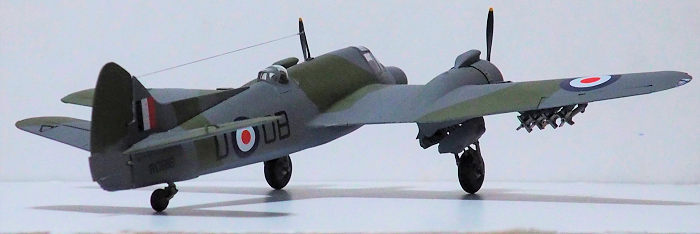
Revell 1/48 Beaufighter TF.X
| KIT #: | 3943 |
| PRICE: | $45.00 |
| DECALS: | |
| REVIEWER: | Mark Rossmann |
| NOTES: | Good kit, some challenges with landing gear and cowling. |

| HISTORY |
First flown in July of 1939, the Beaufighter’s development was fast paced, the first production aircraft was delivered during the ‘Battle of Britain’. The plane was deadly, armed with Hispano 20mm cannon and six Browning 0.303 machine gun, night fighter fitted with AI Mk IV Radar to combat Luftwaffe night intrusion.
 By the
end of the war, the Mosquito had replaced the Beaufighter as the RAF’s
premier night fighter. The final claim, in Europe, occurred with No. 600 Sqn
Ldr G B S Coleman a five-kill ace, shooting down 2-night raiding Stuka’s in
January 1945, that were attacking 8th
Army forward positions. No. 600 Sqn was the top-scoring unit of the war with
180 aerial victories.
By the
end of the war, the Mosquito had replaced the Beaufighter as the RAF’s
premier night fighter. The final claim, in Europe, occurred with No. 600 Sqn
Ldr G B S Coleman a five-kill ace, shooting down 2-night raiding Stuka’s in
January 1945, that were attacking 8th
Army forward positions. No. 600 Sqn was the top-scoring unit of the war with
180 aerial victories.
The Beaufighter was the primary night-fighter in the Burma theater. The final CBI kill, March 25, 1945, occurred when Flt Offs J I H Forbes and H J Pettridge of No 176 Sqn., shot down a Ki-43 Oscar which crashed into the waters of Cheduba Straight to the west of Ramree Island. It was Forbes first and only kill of the war.
The Beau, or Whispering Death, coined by the Japanese, was quiet because of the Hercules engine sleeve valves. These lacked the noisy valve gear common in poppet valved engines, reducing noise levels in the front of the engine
In all, 5,564 were produced in Britain, the last in September of 1945. Another 365 Mark 21 variants was built in Australia, with the last in 1946.
Post War
 The
last RAF Beau flight was at RAF Seletar in Singapore in 1960. Other users
were Turkey, Dominican Republic, Portugal and briefly by Israel.
The
last RAF Beau flight was at RAF Seletar in Singapore in 1960. Other users
were Turkey, Dominican Republic, Portugal and briefly by Israel.
After WWII, No. 45 Sqn, replaced their Mosquitos with the TF Mk.X Beau before deploying to Ceylon. In August 1948, they moved to Kuala Lumpur in to support operation ‘Firedog’, which was the RAF’s contribution to the British involvement in the Malayan Emergency from 1948 to 1960. During WWII Britain supplied Malayan insurgents to resist the Japanese. After the war all insurgents laid down their arms except for the Malayan Races Liberation Army (MLRA), of course a communist organization.
By 1949, Hawker Tempest, Beaufighter, Spitfire FR18 and Avro Lincoln bombers were the mainstay of aircraft. In 1955 the Canberra B.6 was deployed for about 6 months. The ceasefire was announced in January of 1960.
This aircraft represents a TF Mk.X; RD816, “OB.D”, of 45 Squadron, RAF. Deployed for ‘Operation Firedog’ Malaya 1948.
| THE KIT |
 This is the
Revell Beaufighter TF Mk.X, in 1/48. First time building a Beau, so no reference
to the Tamiya kit. Opening you will find the standard solid plastic with no
flash, the engraved lines were relatively soft. Interior is adequate as the
canopy is closed and detail cannot be seen; such as the connecting bulkhead to
the pilot from the rear.
This is the
Revell Beaufighter TF Mk.X, in 1/48. First time building a Beau, so no reference
to the Tamiya kit. Opening you will find the standard solid plastic with no
flash, the engraved lines were relatively soft. Interior is adequate as the
canopy is closed and detail cannot be seen; such as the connecting bulkhead to
the pilot from the rear.
The engine has 3 parts for the cowling, which could easily be 1, it was challenging to keep them in place. Dry fit, attach one let it dry before next is added.
| CONSTRUCTION |
 The most
difficult was the 4-piece landing gear, you have to be really careful
assembling, it can easily be bent out of shape, or broken. Insertion into the
wheel wells is also challenging as they are not solid and hard to keep straight.
The nose cone needs to be carefully fitted and then filled, the kit offers two
tail styles, the fin filet for the Mk.X is what was used for this specific
aircraft, much like the P-51D and P-47D, were fitted to prevent tail flutter.
The most
difficult was the 4-piece landing gear, you have to be really careful
assembling, it can easily be bent out of shape, or broken. Insertion into the
wheel wells is also challenging as they are not solid and hard to keep straight.
The nose cone needs to be carefully fitted and then filled, the kit offers two
tail styles, the fin filet for the Mk.X is what was used for this specific
aircraft, much like the P-51D and P-47D, were fitted to prevent tail flutter.
| COLORS & MARKINGS |
Paint: Tamiya AS-10 RAF Ocean Grey, AS-11 RAF Dark Green. Model Master No. 1920 Intermediate Blue. All are in spray cans.
For decals, I used FREIGHTDOG FSD48-007.
| REFERENCES |
Kit Instructions
Decal sheet
https://en.wikipedia.org/wiki/Malayan_Emergency
11 July 2023 Copyright ModelingMadness.com.
All rights reserved. No reproduction in part or in whole without express
permission. If you would like your product reviewed fairly and
fairly quickly, please
contact
the editor or see other details in the
Note to
Contributors.